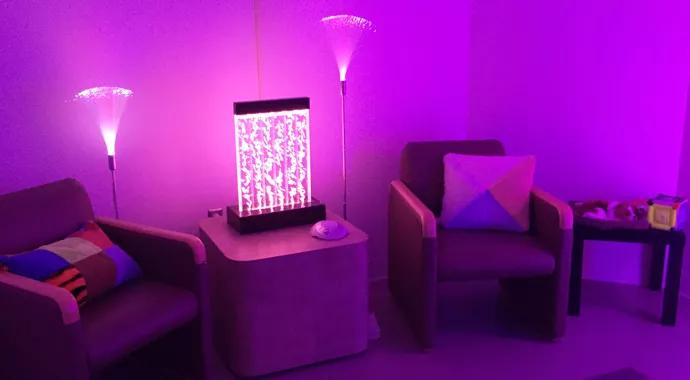Nurses facilitate use for patients with high anxiety

Karen Hogan, DNP, RN, NE-BC, director of behavioral health and the Magnet® program at Cleveland Clinic Marymount Hospital, became interested in the utilization of multisensory environments (MSE) for adult patients with high anxiety years ago. While working for another healthcare system, she created an MSE room – a dedicated space where sensory stimulation can be controlled to reduce anxiety, promote relaxation and encourage communication – on an older adult behavioral unit. Later, she completed an evidence-based practice project on MSE rooms as part of earning her Doctorate in Nursing Practice.
Advertisement
Cleveland Clinic is a non-profit academic medical center. Advertising on our site helps support our mission. We do not endorse non-Cleveland Clinic products or services. Policy
When Hogan joined Marymount Hospital in 2018, the adult behavioral health (ABH) unit was undergoing renovations, providing the ideal opportunity to add MSE as a therapeutic intervention. “Because I saw improvements in patients in my previous position, I felt strongly that we should introduce a multisensory environment to our adult patients at Marymount,” she says. “If you can address and reduce a patient’s anxiety, the hope is that it won’t progress to agitation or aggression.”
With approval of hospital leadership, Hogan and clinical nurses on the ABH unit designed components for MSE rooms and worked with the construction company to modify architectural plans for their inclusion.
Marymount Hospital has 74 beds in four ABH units, three for adults and one for geriatric patients. Three of the four now feature MSE rooms, which the hospital calls “calming rooms,” and a fourth one will be completed when the COVID-19 pandemic subsides.
Opened in the fall of 2019, the calming rooms offer the following:
Advertisement
“If a member of the caregiving team sees somebody who is pacing or showing high anxiety or early agitation, they can suggest the patient go into the calming room,” says Hogan. During the first visit, the caregiver shows the patient all of the options. Then, patients choose the stimulation mode that appeals to them.
“The caregiver’s only job is to facilitate the patient being in the room safely,” says Hogan. “This is the patient’s time, and it needs to be directed by the patient.”
Hogan trained clinical nurses and recreational therapists on using MSE during meetings and huddles, including information on the Brøset Violence Checklist, a violence prediction instrument. The lead recreational therapist provided individual hands-on training of the tools in the calming room. In addition, in September 2019 Hogan conducted a series of education on therapeutic programming with one session devoted to the use of MSE.
Hogan would like to conduct a study on the use of a multisensory environment for adult behavioral health patients. Her hypothesis is that MSE offers several benefits: “I see a reduction in seclusion and restraint, a reduction in PRN medication, a decrease in patient anxiety and agitation, and better patient understanding upon discharge on how to cope with anxiety.”
Anecdotally, Hogan has already witnessed how MSE has benefited patients at Marymount Hospital. Some who have difficulty expressing their feelings have been able to more calmly talk to nurses about their fears and worries while in the calming room, while others have reminisced about positive times in the lives. “One patient who had used the calming room a number of times before asked to use it again,” says Hogan. “When a patient can identify that they need a therapeutic intervention, that’s a really big victory.”
Advertisement
Hogan views MSE rooms as one part of comprehensive care that nurses can offer patients. “It takes a lot of creative ideas to help our patients cope with some of the trauma and fears they have,” she says. “MSE is one way of doing it, but there is no single way. It’s part of the toolbox that caregivers have to use.”
Advertisement
Advertisement

Multidisciplinary approach helps address clinical and psychosocial challenges in geriatric care

Effective screening, advanced treatments can help preserve quality of life

Study suggests inconsistencies in the emergency department evaluation of geriatric patients

Auditory hallucinations lead to unusual diagnosis

How providers can help prevent and address this under-reported form of abuse

How providers can help older adults protect their assets and personal agency

Recognizing the subtle but destructive signs of psychological abuse in geriatric patients

Early screening — and shorter boarding times — benefit older adults